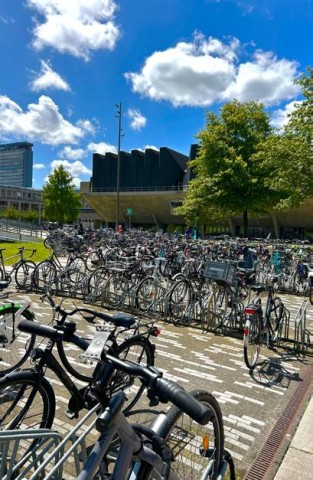Special Issue: Open Science in its many forms - How open data fuels smarter micro-mobility?
Newsletter
As cities turn to micro-mobility—think shared bikes, e-scooters, and e-bikes—open data is the force behind smarter, adaptable transit solutions. By sharing real-time traffic, environmental, and infrastructure data, cities and operators can create efficient, responsive systems. Discover how open data fuels the future of urban mobility, making cities greener and more connected.
Bionote
Linda is a second-year PhD student focusing on modeling, optimization, AI, and data- driven methods for sustainable mobility, supervised by Zargayouna, Ameli, and Ramezani. She is also an MSCA-ClearDoc fellow. Mostafa is a Associate Professor at GRETTIA, University Gustave Eiffel, specializing in operations research for transportation systems. Mohsen is an Associate Professor at the University of Sydney, with expertise in transport engineering and control systems. Mahdi is Deputy Director of GRETTIA at Université Gustave Eiffel, focusing on multi-agent systems and complex transport applications. All are dedicated to advancing innovative approaches in transportation challenges.

While cities grapple with congestion, pollution, and an ever-growing population, the spotlight is on micro-mobility—shared e-scooters, bikes, and e-bikes—as a sustainable solution to urban transportation woes. But what makes these systems truly "smart"? The answer lies in open data. This freely accessible data fuels innovation, helping cities create micro-mobility networks that are efficient, responsive, and aligned with modern urban needs. Open data is not just a tool; it is the foundation of a smarter, data-driven approach to city mobility.
Open data: The hidden powerhouse behind micro-mobility
Open data refers to data made publicly available without restrictive barriers, opening doors to real-time traffic updates, route optimization, and more. By sharing data on city infrastructure, traffic, and environmental factors, cities allow micro-mobility providers to craft services tailored to riders' needs. Take the European Union’s National Access Point (NAP) directive, which mandates a central data hub in each member state. This directive helps developers and researchers access standardized transportation data, driving innovation and interoperability across different transport modes and cities.
To keep micro-mobility systems moving smoothly, a range of data types is critical:
• Traffic data: Real-time congestion, road closures, and incidents inform optimal routes for e-scooters and bikes. For example, Citymapper in London integrates open traffic data, guiding users with multiple transit options, including micro- mobility.
• Environmental data: Weather and air quality data influence route choices, promoting paths with cleaner air and aligning with health and sustainability goals.
• Infrastructure data: Information on bike lanes, parking zones, and pedestrian pathways enables seamless navigation. Helsinki’s open data maps, for instance, help providers align their routes to city pathways.
• Demand data: Usage patterns indicate high-demand areas, allowing efficient fleet distribution to meet urban demand.

Cities paving the way with open data innovations
Across the globe, cities are leading by example. Barcelona’s Apps4BCN initiative encourages developers to use open transport data, resulting in apps like Smou, which consolidates parking and bike-sharing data to make urban commuting seamless. In New York, the open data portal provides datasets on subway schedules, bike dock availability, and traffic congestion. This information powers Citi Bike, the city’s primary bike- sharing program, which combines bike availability and traffic data to provide riders with efficient, safe routes.
Despite the clear benefits, there are challenges to making open data work for micro-mobility. Data quality varies—real- time traffic updates are essential but are sometimes inconsistently refreshed. Privacy is another major concern. To protect user identities, cities like Amsterdam enforce strict data anonymization, enabling the use of aggregated mobility data without compromising privacy. Additionally, different data formats across cities make it tough for micro-mobility providers to scale their services. Initiatives like the Open Mobility Foundation’s Mobility Data Specification (MDS) aim to harmonize standards, encouraging cross-city collaboration.
AI: The brain behind intelligent micro-mobility
Artificial intelligence (AI) is crucial in transforming open data into valuable insights. Machine learning algorithms analyze traffic, predict demand, and suggest alternative routes, enabling cities to adapt in real-time. Multimodal journey planners, like Google Maps, integrate micro-mobility options, guiding users to switch between transport modes based on changing conditions. San Francisco’s SFMTA, for example, uses AI models to predict areas of high micro mobility demand, helping operators efficiently allocate vehicles where they’re needed most. A recent work by our team in the GRETTIA lab (Université Gustave Eiffel) explores the usage of various open data sources to predict micromobility usage for multi-modal city-wide networks.
Why open data is a win for everyone
The benefits of open data in micro-mobility are far-reaching:
• Better user experience: With real-time data, users can plan routes based on accurate schedules and bike availability, ensuring a smooth experience.
• Environmental gains: Data-driven route optimization and fleet management help cities reduce emissions, promoting greener, low-carbon transit options.
• Economic efficiency: Both cities and operators gain from efficient fleet management, which minimizes idle time and optimizes routes.
• Public trust: Transparency builds trust, with residents more likely to embrace shared mobility when they see concrete benefits.
Creating a successful open data ecosystem requires cooperation between public institutions and private operators. Cities provide the regulatory framework, while operators use data insights to improve services and fleet distribution. This collaboration is essential for a micro-mobility system that meets urban mobility needs and aligns with city goals.
The future of open data in micro-mobility
As urban areas evolve toward sustainable transportation, open data will play a key role. Addressing challenges around data quality, privacy, and standardization requires a united effort and clear protocols. With AI-driven insights layered onto open data, cities can build dynamic, responsive micro- mobility systems that not only enhance user experiences but also contribute to a sustainable future in urban transport. Open data has the power to reshape city mobility, setting the stage for a smarter, more connected urban landscape.

Linda Belkessa
LinkedIn
MSCA ClearDoc fellow,
GRETTIA-COSYS, Université Gustave Eiffel
Mahdi Zargayouna
LinkedIn
GRETTIA, Université Gustave Eiffel
Mostafa Ameli
LinkedIn
GRETTIA, Université Gustave Eiffel
Research Affiliate in UC Berkeley
Mohsen Ramezani
School of Civil Engineering, University of Sydney
Acknowledgements: The project is supported by the EU Horizon 2020 research and innovation program under the Marie Sklodowska-Curie COFUND grant agreement no. 101034248.
Further reading
European Commission. (2017). National access points (NAP) for intelligent transport systems. European Union. https://ec.europa.eu/transport
Citymapper. (n.d.). Citymapper app: Live transit and route information in London. https://citymapper.com
City of Helsinki. (2023). Helsinki region infoshare - Open data map service. Helsinki Region Infoshare. https://hri.fi
Barcelona City Council. (n.d.). Apps4BCN: Open data initiative for urban mobility. https://barcelona.cat
New York City. (2023). NYC open data - Transportation datasets. NYC Open Data. https://opendata.cityofnewyork.us
Open Mobility Foundation. (n.d.). Mobility data specification (MDS). https://www.openmobilityfoundation.org
San Francisco Municipal Transportation Agency. (2023). SFMTA and open data initiatives. https://www.sfmta.com
Belkessa, L., Ameli, M., Ramezani, M., & Zargayouna, M. (2024). Multi-channel spatio-temporal graph convolutional networks for accurate micro mobility demand prediction integrating public transport data. In Proceedings of the 2nd ACM SIGSPATIAL Workshop on Sustainable Urban Mobility (pp. 5–13). Association for Computing Machinery. https://doi.org/10.1145/3681779.3696841